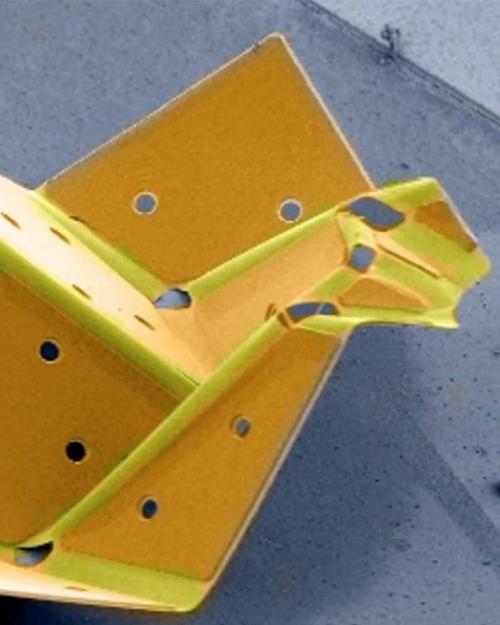If you want to build a fully functional nanosized robot, you need to incorporate a host of capabilities, from complicated electronic circuits and photovoltaics to sensors and antennas.
But just as importantly, if you want your robot to move, you need it to be able to bend.
Cornell researchers have created micron-sized shape memory actuators that enable atomically thin two-dimensional materials to fold themselves into 3D configurations. All they require is a quick jolt of voltage. And once the material is bent, it holds its shape – even after the voltage is removed.
As a demonstration, the team created what is potentially the world’s smallest self-folding origami bird. And it’s not a lark.
The group’s paper, “Micrometer-Sized Electrically Programmable Shape Memory Actuators for Low-Power Microrobotics,” published March 17 in Science Robotics and was featured on the cover. The paper’s lead author is postdoctoral researcher Qingkun Liu.
The project is led by Itai Cohen, professor of physics, and Paul McEuen, the John A. Newman Professor of Physical Science, both in the College of Arts and Sciences.
“We humans, our defining characteristic is we’ve learned how to build complex systems and machines at human scales, and at enormous scales as well,” said McEuen. “But what we haven't learned how to do is build machines at tiny scales. And this is a step in that basic, fundamental evolution in what humans can do, of learning how to construct machines that are as small as cells.”
McEuen and Cohen’s ongoing collaboration has so far generated a throng of nanoscale machines and components, each seemingly faster, smarter and more elegant than the last.
“We want to have robots that are microscopic but have brains on board. So that means you need to have appendages that are driven by complementary metal-oxide-semiconductor (CMOS) transistors, basically a computer chip on a robot that’s 100 microns on a side,” Cohen said.
Imagine a million fabricated microscopic robots releasing from a wafer that fold themselves into shape, crawl free and go about their tasks, even assembling into more complicated structures. That’s the vision.
“The hard part is making the materials that respond to the CMOS circuits,” Cohen said. “And this is what Qingkun and his colleagues have done with this shape memory actuator that you can drive with voltage and make it hold a bent shape.”
These actuators can bend with a radius of curvature smaller than a micron – the highest curvatures of any voltage-driven actuator by an order of magnitude. This flexibility is important because one of the bedrock principles of microscopic robot manufacturing is that the robot size is determined by how small the various appendages can be made to fold. The tighter the bends, the smaller the folds, and the tinier the footprint for each machine. It’s also important that these bends can be held by the robot, which minimizes the power consumption, a feature especially advantageous for microscopic robots and machines.
Cohen and McEuen credit Liu’s background in chemistry with giving the project an extra jolt, to nail down the science behind the electrochemical reaction that enables the material to fold and maintain its shape.
“At this small scale, it’s not like traditional mechanical engineering, but rather chemistry, material science and mechanical engineering all mixed together,” Liu said.
The devices consist of a nanometer-thin layer of platinum capped with a titanium or titanium dioxide film. Several rigid panels of silicon dioxide glass sit atop those layers. When a positive voltage is applied to the actuators, oxygen atoms are driven into the platinum and swap places with platinum atoms. This process, called oxidation, causes the platinum to expand on one side in the seams between the inert glass panels, which bends the structure into its predesignated shape.
The machines can hold that shape even after the voltage is removed because the embedded oxygen atoms bunch up to form a barrier, which prevents them from diffusing out.
By applying a negative voltage to the device, the researchers can remove the oxygen atoms and quickly restore the platinum to its pristine state. And by varying the pattern of the glass panels, and whether the platinum is exposed on the top or bottom, they can create a range of origami structures actuated by mountain and valley folds.
“One thing that’s quite remarkable is that these little tiny layers are only about 30 atoms thick, compared to a sheet of paper, which might be 100,000 atoms thick. So it’s an enormous engineering challenge to figure out how to make something like that have the kind of functionalities we want,” said McEuen, who co-chairs the Nanoscale Science and Microsystems Engineering (NEXT Nano) Task Force, part of the provost’s Radical Collaboration initiative, and directs the Kavli Institute at Cornell for Nanoscale Science.
The machines fold themselves fast, within 100 milliseconds. They can also flatten and refold themselves thousands of times. And they only need a single volt to be powered to life.
“These are major advances over current state-of-the-art devices,” Cohen said. “We’re really in a class of our own.”
The team has already been recognized by Guinness World Records for creating the smallest walking robot. Now, they hope to capture another record with a new self-folding origami bird that is only 60 microns wide.
The team is currently working to integrate their shape memory actuators with circuits to make walking robots with foldable legs as well as sheet-like robots that move by undulating forward. These innovations may someday lead to nano-Roomba-type robots that can clean bacterial infection from human tissue, micro-factories that can transform manufacturing, and robotic surgical instruments that are ten times smaller than current devices, according to Cohen.
But an equally important question driving the team is: what are the principles that need to change in order to design, manufacture and operate machines at this scale?
The team worked with co-authors David Muller, the Samuel B. Eckert Professor of Engineering, to image their nanoscale structures, and Tomas Arias, professor of physics and a Stephen H. Weiss Presidential Fellow, to better understand the process driving the actuation.
Co-authors include doctoral students Wei Wang, Michael Reynolds and Michael Cao ’14; and former postdoctoral researcher Marc Miskin, who is now an assistant professor at the University of Pennsylvania.
“Dr. Cohen and his team are pushing the boundary of how quickly and precisely we can control motion at the micro- and even nano-scales,” said Dean Culver, program manager for the Army Research Office, an element of the U.S. Army Combat Capabilities Development Command’s Army Research Laboratory, which supported the research. “In addition to paving the way for nano-robots, the scientific advancements from this effort can enable smart material design and interaction with the molecular biological world that can assist the Army like never before.”
Additional support was provided by the National Science Foundation, the Cornell Center for Materials Research, the Air Force Office of Scientific Research, and the Kavli Institute at Cornell for Nanoscale Science. Part of the work was performed at the Cornell NanoScale Science and Technology Facility.





